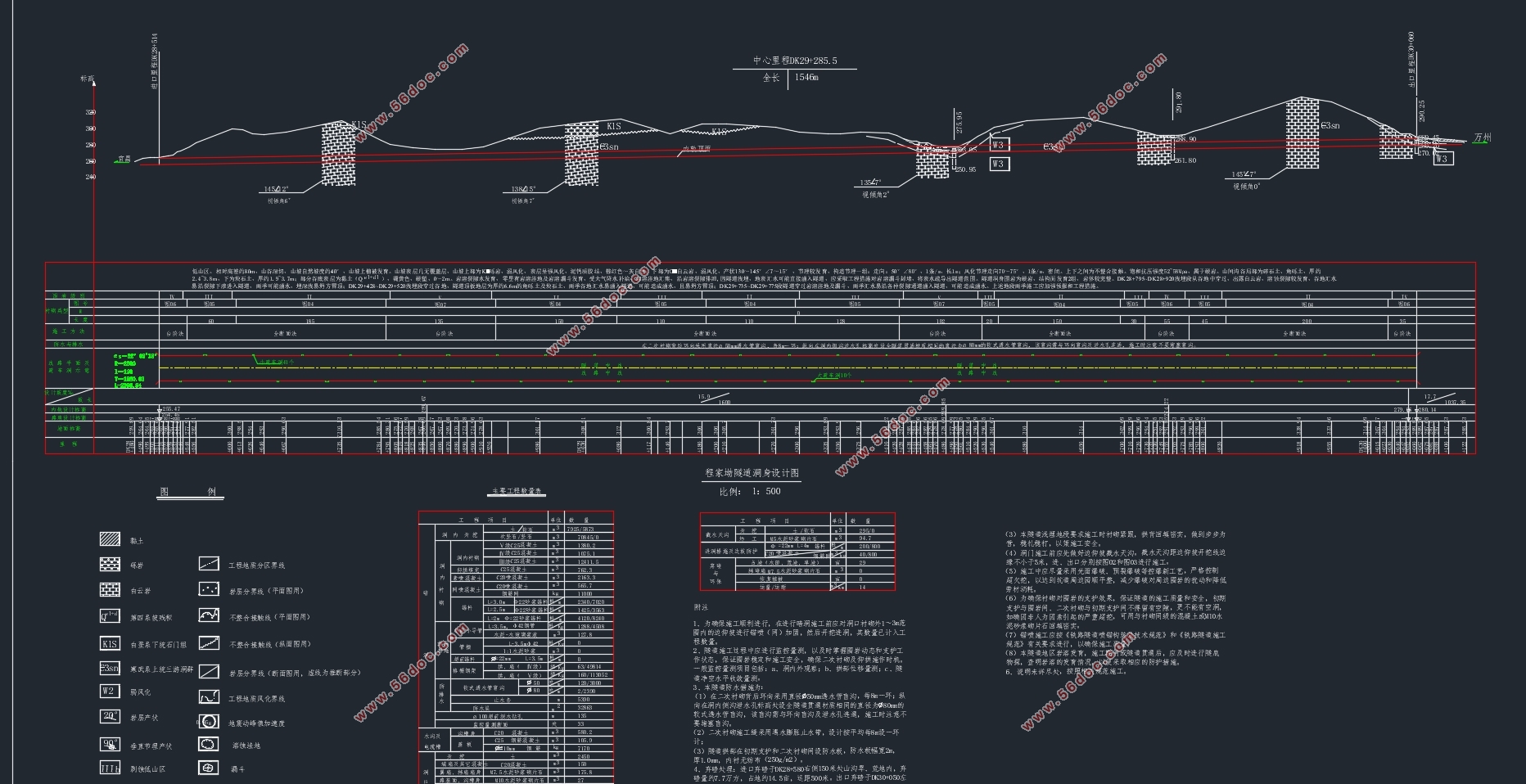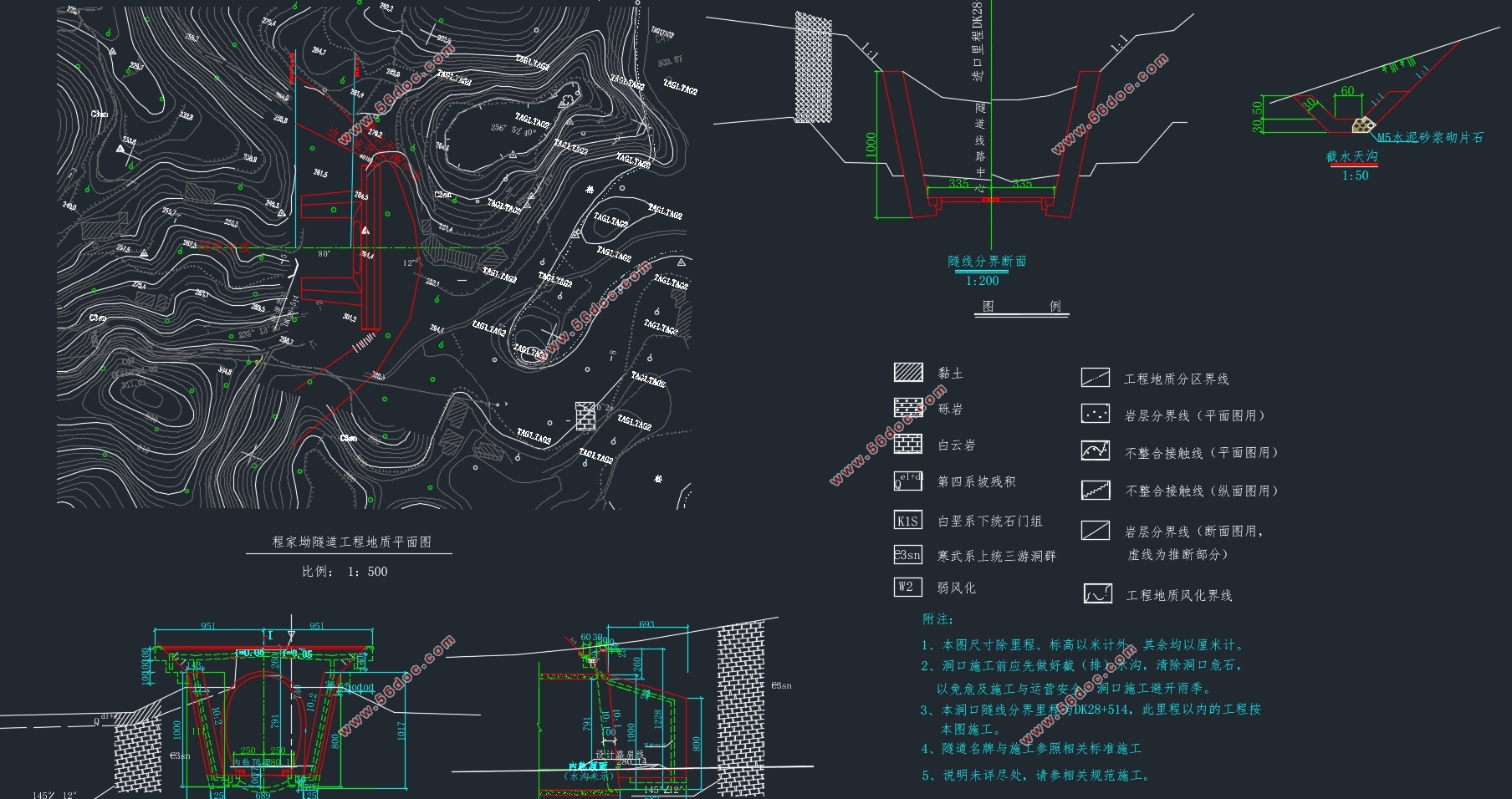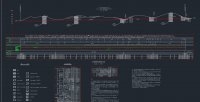全长1546m程家坳铁路隧道设计(含CAD图)(任务书,开题报告,论文计算书12000字,CAD图7张)
摘要
此设计为一条全长为1546m的铁路隧道设计,名为程家坳铁路隧道,根据需要将此隧道设计为单轨轨道,车速160km/h。隧道的衬砌结构设计施工选用当下十分流行的新奥法,采取将锚杆以及喷射混凝土作为主要支护手段再辅以其它支护的方式,将围岩和喷射的混 的围岩分段皆选择涵有初衬和二衬的复合式衬砌。此外,在进行隧道掘进过程中,根据开挖地段围岩级别的不同,II、III级围岩段将采取全断面法,而IV和V级围岩段选用台阶 件对衬砌结构进行内力分析以及墙面强度检算,同时完成配筋计算。此外,通过查询有关资料以及工程实例完成了隧道施工方案设计、衬砌结构的设计和隧道附属设备的设计,并绘制了对应的CAD图纸。
关键词:铁路隧道;新奥法;复合式衬砌;翼墙式洞门;支护
Abstract
This design is a full-length 1546m railway tunnel design, called Chengjiaao railway tunnel, according to the need to design the tunnel as a monorail track, speed 160km / h.Tunnel lining structure design and construction of the current very popular new Austrian law, to take the anchor and shotcrete as the main means of support and then supplemented by other means of support, the surrounding rock and spray the concrete into a whole together to withstand the Rock pressure.The classification of the surrounding rock of the tunnel is relatively complex, the level of the surrounding rock, including II, III, IV, V three. After the integration of the design requirements of the tunnel and geological conditions and other factors after the III, IV, V class of the surrounding rock section are selected with the first lining and two lining of the composite lining.In addition, during the tunneling process, according to the different levels of the surrounding rock of the excavation section, the second and third grade surrounding rock sections will take the full cross-section method, while the IV and V-stage rock sections.In the design of the hole when the hole according to the location of the geological conditions and the design of the tunnel entrance and exit doors are used wing wall.In addition, through the query of the relevant information and engineering examples to complete the tunnel construction program design, the design of the lining structure and tunnel ancillary equipment design, and draw the corresponding CAD drawings.
Key Words:railway tunnel;NATM;composite lining;wing wall tunnel portal;Support
工程概况
2.1地理位置
本隧道的施工工点位于地势较低的山区,地面有许多坑洼,起伏不定。设计隧道总长度达到1546米,设计入口位置将位于里程DK28+514,出口位置位于里程DK30+060.
2.2地形地貌
本隧道的施工地区相对高差较大,在80m左右,所要经过的地区属于低丘陵地区,可能会有不太稳定的山坡发生下沉或者滑移。地质、地形条件复杂多变,地形起伏不定,变化较大,一部分地段土层分布较薄,少许地段几乎没有覆盖层。山坡的坡度较大,达到了 ,山坡上种植有大量的灌木松树以及松树等。隧道要经过的一些地段的地表水较发育且有可能会遇到岩溶洼地以及不大的岩溶漏斗,不过正常涌水量和最大涌水量都比较小,在进行施工前还应作好地表水的排除工作,防止其流入隧道造成施工的不便。
2.2.1地层岩性地质构造
地层的详细情况如下所示:
(1)山坡上部表面一层为砾岩,岩石比较松散,风化程度不高,其单轴抗压强度大约在1.45~1.98Mpa之间;山坡的表层为棕色和浅灰色的钙质胶结物,如砂岩等,风化程度有点严重,其单轴抗压强度在0.18~0.48Mpa之间。
(2)山坡下部多为硬度较小,呈灰白色的白云岩,期间夹杂着少许黏土矿物,它的风化程度不高,岩石单轴抗压强度超过4.0Mpa。
有1.85m,厚的不超过3.65m,单轴抗压强度在0.45~0.65Mpa之间,局部地区在施工时有可能会发生塌陷,需注意提前进行支护。
(4)一部分山谷谷底表面一层岩石岩性为呈褐黄色的硬塑黏土,其厚度在0~3m之间,单轴抗压强度为0.14~0.19Mpa。
2.3水文地质条件
本隧道所经之处部分地段岩溶裂隙水相对较发育,且刚好要穿过地下水垂直渗流带,中间的一部分浅埋地段在雨季可能会发生山坡上的泥土随着雨水冲刷隧道顶部导致隧道出现漏顶、滑移等现象。



目录
第一章 绪论 1
1.1课题的研究目的与意义 1
1.2国内外隧道发展现状 1
第二章 工程概况 2
2.1地理位置 2
2.2地形地貌 2
2.2.1地层岩性地质构造 2
2.3水文地质条件 2
2.4围岩分级 3
第三章 隧道洞口及断面设计 4
3.1洞口位置的选择 4
3.2洞门形式的选择 5
3.3洞口边、仰坡的拟定和洞口里程的确定 5
3.4隧道洞口位置的确定 5
3.5洞门检算 6
3.5.1入口洞门基本计算数据 6
3.5.2出口洞门基本计算数据 13
3.6隧道纵断面设计 18
3.6.1坡道形式 18
3.6.2 坡度大小 19
3.6.3坡段长度 20
3.6.4坡段连接 20
3.7隧道横断面设计 20
3.7.1隧道横断面的介绍 20
3.7.2本隧道横断面设计 21
第四章 隧道支护结构的设计 22
4.1隧道预支护设计 22
4.1.1超前锚杆设计 22
4.1.2小导管注浆设计 22
4.1.3管棚设计 23
4.2隧道初期支护设计与计算 23
4.2.1概述 23
4.2.2初期支护的设计 23
4.2.3 V级围岩初期支护机构计算 23
4.3.1喷混凝土提供的支护抗力 值 24
4.3.2钢支撑提供的支护抗力P2值 26
4.3.3锚杆提供的支护抗力 值 26
4.3.4围岩本身提供的支护抗力 值 28
4.3.5最小支护抗力值 29
4.3隧道二次衬砌设计与计算 32
4.3.1围岩压力确定公式 32
4.3.2衬砌围岩压力确定 33
4.3.3衬砌结构的理想化 36
4.3.4V级围岩衬砌截面的强度检算 36
4.3.5配筋 37
4.3.6 II级围岩二次衬砌结构检算 39
4.4通风设计 47
4.5附属设备设计 48
4.5.1避车洞的布置 48
4.5.2照明设计 48
第五章 施工组织设计 49
5.1洞口施工 49
5.2 洞身段的施工 49
5.2.1全断面法:全断面开挖一次成型 49
5.2.2台阶法:分为上、下台阶开挖 50
5.3不良地质隧道施工 50
5.3.1岩溶地段施工 50
5.4弃渣处理 51
第六章 结论 52
参考文献 53
致谢 54
附录 55
附录A 55
附录B 56
附录C 60
附录D 61
附录E 63
|







